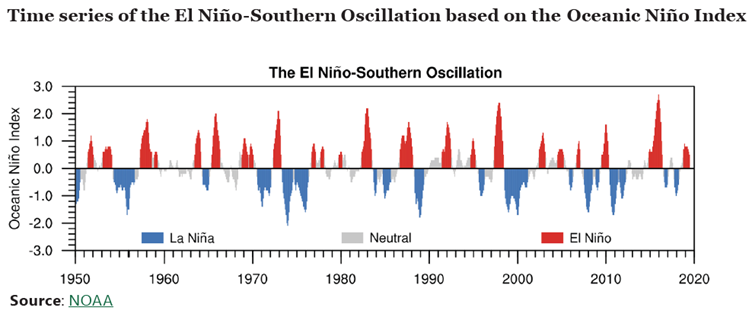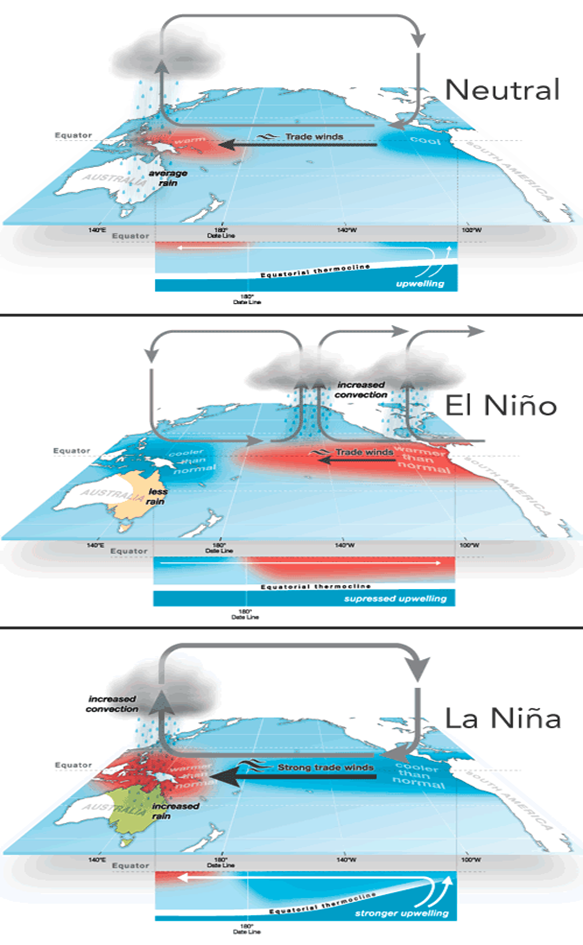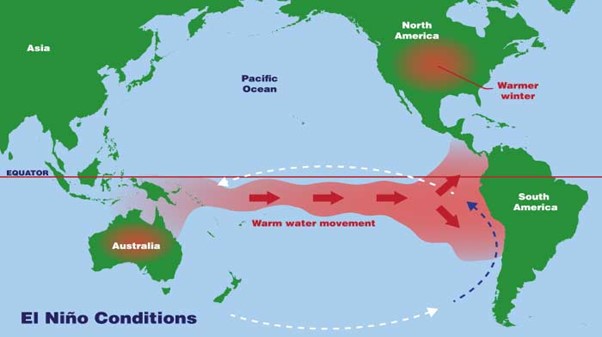La Niña and El Niño are two interrelated oceanic and atmospheric phenomena that occur in the tropical Pacific Ocean. They are part of a larger climate pattern known as the El Niño-Southern Oscillation (ENSO), which refers to the cycle of warm and cool oceanic temperatures that occurs every few years.

El Niño and La Niña can have significant impacts on agriculture and food production around the world, particularly in regions that are heavily dependent on rainfall for crop growth. The impacts of these phenomena on agriculture can vary depending on the strength and duration of the events, as well as other factors such as regional geography and soil type.
In regions that experience floods or drought, crops can be affected. Excess moisture can lead to waterlogging of fields, which can damage or kill crops. Floods can also lead to soil erosion, the spread of plant diseases, and the loss of crops and livestock. Drought can lead to lower crop yields, reduced crop quality, and higher food prices. In addition, drought can lead to increased water scarcity and stress on natural ecosystems.
Overall, the impacts of El Niño and La Niña on agriculture can have significant economic and social consequences, particularly in developing countries where food security is a major issue. The ability of farmers and governments to adapt to and mitigate the impacts of these phenomena can be critical for maintaining food security and livelihoods.

Source: Australian Government BOM
El Niño: El Niño is a phenomenon that occurs when oceanic temperatures in the central and eastern Pacific become warmer than average, disrupting normal weather patterns around the world. The warming of the Pacific Ocean occurs when trade winds weaken, and warm water that is normally pushed towards the western Pacific begins to move eastward, towards South America.
average, disrupting normal weather patterns around the world. The warming of the Pacific Ocean occurs when trade winds weaken, and warm water that is normally pushed towards the western Pacific begins to move eastward, towards South America.
During an El Niño event, there is a reduction in rainfall over Southeast Asia, Indonesia, and Australia, while the Americas experience above-average rainfall. This can lead to droughts, wildfires, and crop failures in some regions, while other regions may experience heavy rainfall and flooding.
(Source: Lets talk Geography)
La Niña: La Niña is the opposite of El Niño, occurring when oceanic temperatures in the central and eastern Pacific become cooler than average. This is caused by strengthening of trade winds, which push warm surface waters towards the western Pacific, allowing cooler, nutrient-rich waters to upwell to the surface in the eastern Pacific.

(Source: Lets talk Geography)
During a La Niña event, there is an increase in rainfall over Southeast Asia, Indonesia, and Australia, while the Americas experience below-average rainfall. This can lead to floods and landslides in some regions, while other regions may experience droughts.
Effects on Global Weather:
Both El Niño and La Niña can have significant effects on global weather patterns, as they can alter the jet stream, which is responsible for steering weather systems around the world. They can also affect ocean currents, which can have cascading effects on marine ecosystems and fisheries.
It is important to note that while El Niño and La Niña events are associated with certain patterns of global weather, they do not guarantee specific outcomes. The strength and duration of the events, as well as other factors such as regional geography and topography, can all influence the impacts of El Niño and La Niña on local weather patterns.
During an El Niño event, there is a reduction in rainfall over Southeast Asia, Indonesia, and Australia, while the Americas experience above-average rainfall. This can lead to droughts, wildfires, and crop failures in some regions, while other regions may experience heavy rainfall and flooding. The below graph shows the relationship between El Niño events and rainfall anomalies in different parts of the world.
La Niña is the opposite of El Niño, occurring when oceanic temperatures in the central and eastern Pacific become cooler than average. This is caused by strengthening of trade winds, which push warm surface waters towards the western Pacific, allowing cooler, nutrient-rich waters to upwell to the surface in the eastern Pacific.
During a La Niña event, there is an increase in rainfall over Southeast Asia, Indonesia, and Australia, while the Americas experience below-average rainfall. This can lead to floods and landslides in some regions, while other regions may experience droughts. The below graph shows the relationship between La Niña events and rainfall anomalies in different parts of the world.
It is important to note that while El Niño and La Niña events are associated with certain patterns of global weather, they do not guarantee specific outcomes. The strength and duration of the events, as well as other factors such as regional geography and topography, can all influence the impacts of El Niño and La Niña on local weather patterns.
The below image shows the typical oceanic temperature pattern during La Niña and El Niño events, as well as neutral conditions. During a La Niña event, the cooler-than-average water temperatures are concentrated in the eastern Pacific, while warmer water is present in the western Pacific.


El Nino and La Nina impact on Indian Agriculture
El Niño and La Niña can have significant impacts on Indian agriculture, as India is heavily dependent on rainfall for crop growth and food production. The impacts of these phenomena on Indian agriculture can vary depending on the strength and duration of the events, as well as other factors such as regional geography and soil type.
During an El Niño event, there is a reduction in rainfall over India, particularly in the northern and eastern regions. This can lead to droughts, wildfires, and crop failures in some regions, while other regions may experience heavy rainfall and flooding. India experiences weak and erratic monsoon rains, resulting in drought conditions in many regions. This can negatively impact crop yields and production, particularly for crops like rice, sugarcane, and cotton. According to some studies, during El Niño years, India’s Kharif production can be reduced by 7-15%.
During neutral years, India experiences average monsoon rainfall, which is considered ideal for Kharif production. However, other factors like temperature, humidity, and soil moisture also play a significant role in determining crop yields and production.
During a La Niña event, there is an increase in rainfall over India, particularly in the southern and eastern regions. This can lead to floods and landslides in some regions, while other regions may experience droughts. India experiences above-average rainfall, particularly in the southern and eastern regions. This can result in floods and waterlogging, which can damage crops and reduce yields. However, if the rainfall is well-distributed and not excessive, it can benefit crops like rice, sugarcane, and cotton, resulting in higher yields and production.
The below graph shows the relationship between ENSO events and rainfall anomalies in India:

Impacts of El Niño on crop yield anomalies for four crops.

Impacts of La Niña on crop yield anomalies for four crops.

(Source : Nature Communication – Paper : Impacts of El Nin˜o Southern Oscillation on the global yields of major crops)
Overall, the impacts of El Niño and La Niña on Indian agriculture can have significant economic and social consequences, particularly in rural areas where livelihoods are heavily dependent on agriculture. The ability of farmers and the Indian government to adapt to and mitigate the impacts of these phenomena can be critical for maintaining food security and livelihoods.
The impact of El Niño and La Niña on India’s Kharif production can vary depending on the severity and duration of the events. Production can vary from year to year, depending on various factors like regional weather patterns, soil type, and crop variety. It’s always advisable to monitor the latest weather forecasts and advisories from local authorities to mitigate the impact of adverse weather conditions on crop production.
Here are the graphs showing the India’s foodgrain Production ( in Kharif and Rabi Season) during selected El Niño and La Niña years from 19772 to 2022:


Note: Other factors such as government policies, market prices, and technological advancements can also impact crop production in addition to weather patterns.
El Niño-Southern Oscillation (ENSO) Current situation/Forecast
The El Niño-Southern Oscillation (ENSO) is currently in a neutral state. El Niño conditions are forecast to develop during the next several months. There is a 62 percent chance of El Niño during May-June-July with increasing chances afterwards until an 86 percent chance during October-November-December, according to the IRI/CPC forecast.
El Niño events can have widespread, global impacts. These tend to enhance rainfall in Central Asia, southern North America, south-eastern South America, southern Europe, eastern and southern East Africa, and southern and eastern China. Drier-than-average conditions tend to occur in Central America, the Caribbean, northern South America, parts of western and northern East Africa, Southern Africa, India, Northern China, the Maritime Continent, and Australia.
Positive Indian Ocean Dipole (IOD) conditions may also develop during June to September, according to the Australian Bureau of Meteorology forecast. Positive IOD conditions can enhance El Niño-related drying influences in Australia and the Maritime Continent, and wetting influences during the East Africa short rains. (Source: UCSB Climate Hazards Center)
In Detail: Current situation/Forecast
After experiencing three consecutive years of La Niña that brought bumper crops for some and crop failures for others, we are likely heading right into an El Niño. This will make a lot of farmers happy who have been suffering these past years while shifting the agony elsewhere.
The El Niño-Southern Oscillation (ENSO) is currently neutral, but it will likely not stay that way for long. Both the Australian Bureau of Meteorology (BoM) and the Climate Prediction Center (CPC) of the National Oceanic and Atmospheric Administration (NOAA) from the US have now issued an El Niño Watch. El Niño could occur as soon as during May-June-July, with a 62 percent chance of development during that time according to NOAA CPC forecasts. After that, the chances of development continue going up with a 75 percent chance during June- July-August, followed by an 80 percent chance or greater for the rest of the year. While forecasts made during this time of the year tend to be less accurate than those later in the season, there are a lot of signs suggesting that El Niño might be just around the corner.
Strength and Precipitation Changes Strength matters. The stronger the ENSO event, the further reaching and the more severe the global climate impacts are likely to be. Events are broken down into either weak, moderate, strong, or very strong. By the end of the year, when El Niños typically reach their peak strength, the current forecast is for about a 40 percent chance of the event becoming a strong one. Should El Niño materialize and depending on its strength, average to above-average rains could occur in Central Asia, southern North America, southeast South America, southern Europe, eastern and southern East Africa, and southern and eastern China. Drier-than-average conditions could occur in Central America, the Caribbean, parts of western and northern East Africa, northern South America, Southern Africa, India, Northern China, the Maritime Continent, and Australia.

Source :IRI

Potential Crop Impacts
Agricultural areas with a high correlation between dry/wet conditions and El Niño events and crops affected

ENSO events are estimated to affect crop yields on over 25 percent of global croplands. While crop yields are not affected every year, El Niño events have been generally shown to slightly improve global-mean soybean yields, while slightly decreasing global-mean maize, rice, and wheat yields. Maize tends to be impacted more than the other crops. Also, negative impacts tend to be lessened for irrigated crops compared with those that are rainfed.
How the current potential El Niño event will impact agricultural production is uncertain as no two events are the same with regards to strength, duration, or localized mitigations.
However, based on historical El Niño events, some crops and regions can be highlighted as being likely to have yield impacts. For maize and soybeans, yields will likely be positively impacted in parts of the Midwest US and southeast South America, while negatively impacted in the North China Plain, southern Mexico, northeast Brazil, India, Indonesia, West Africa, and Southern Africa. For wheat, yields will likely be positively impacted for the US southern Great Plains, China, Central Asia, and southeast South America, while negatively impacted in southeast Australia. For rice, negative impacts are possible across all of Southeast Asia.
While El Niño can significantly lower crop yields in some regions, at the global level, there is a chance that the negative yield impacts in the major producing countries could be partially offset. Thus, reductions in yields in one region might be balanced by increases in another. However, only when the El Niño event begins to ramp up will its true impacts on agriculture begin to be known.
Source: AMIS:The EL Nino Current Situation above text is an extract from the AMIS May 2023 market monitor published this week. To read the complete edition click here.